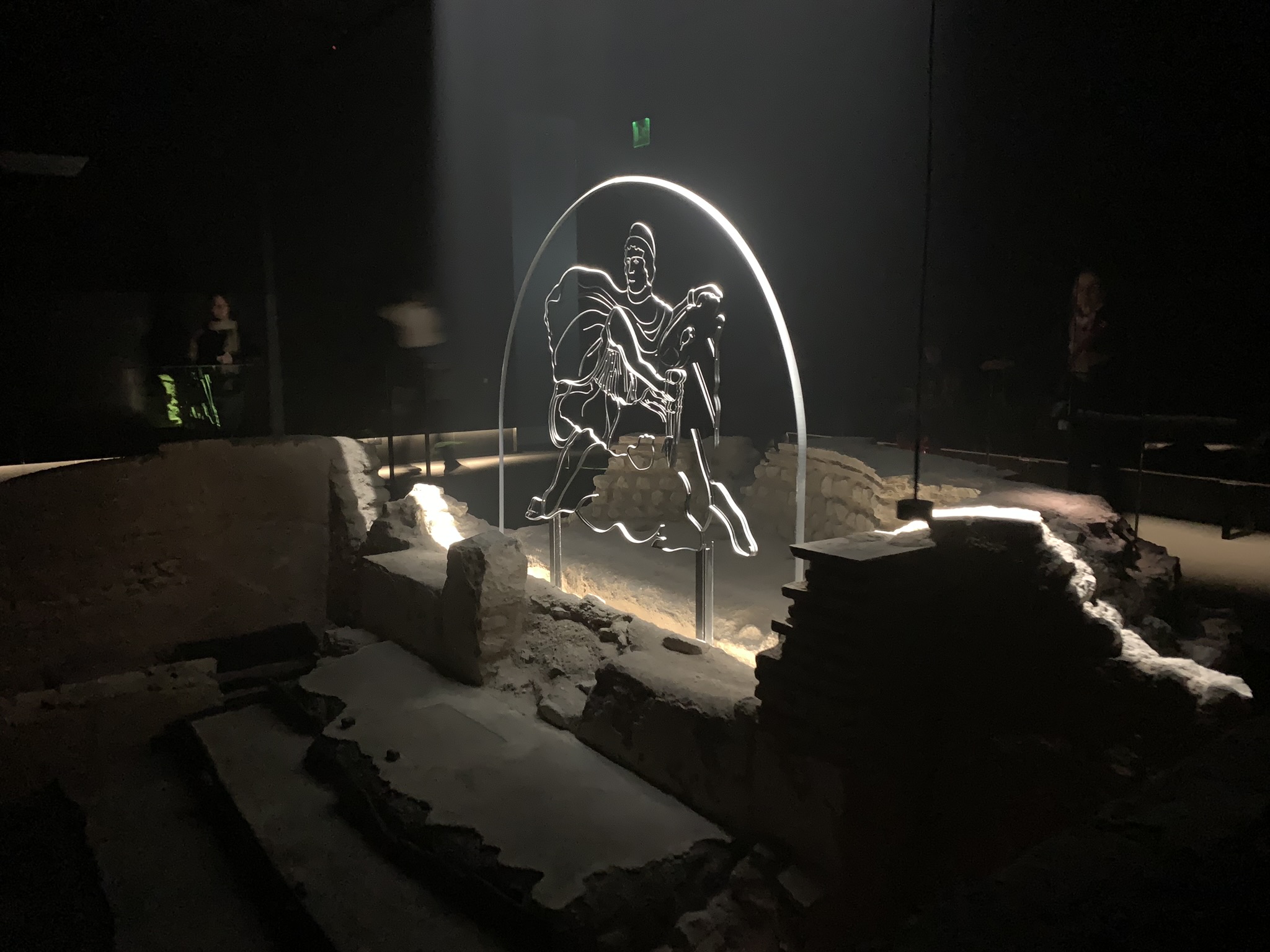
An ancient, candle-lit, cavern where sacred meals were consumed, animals sacrificed, and cultists put through brutal initiation ceremonies – all in the name of Mithras. Small temples or Mithraeums, can be found across the former Roman Empire, including in Londinium.
The Cult of Mithras
The polytheistic nature of both Greek and Roman faith allowed room for many ‘mystery religions’ to crop up. These cults would focus on a specific deity and followers would meet to worship, network and gossip.
Centred on the god Mithras, Mithraism first appeared in the 1st Century CE and quickly spread across the Roman Empire.
Mithratic initiates worshiped in small underground temples called Mithraeums. These temples consisted of a nave flanked by two aisles with seating for 20 to 30 people. This was set up like a dining room to facilitate a holy meal that was an important part of worship.
Over 100 Mithraeums have been found but around 1,000 were said to have existed at the cult’s peak. Despite this, no contemporary account of Mithraism has been found.
Knowledge of the cult instead comes from interpretation of archaeological finds or Christian propaganda. So, all claims about the cult must be taken with a pinch of salt.
The Mithratic creation myth is that Mithras was born from a stone, slayed a bull and then sat down to feast on the bull with the Roman god Sol Invictus. This in turn, led to the creation of humanity.
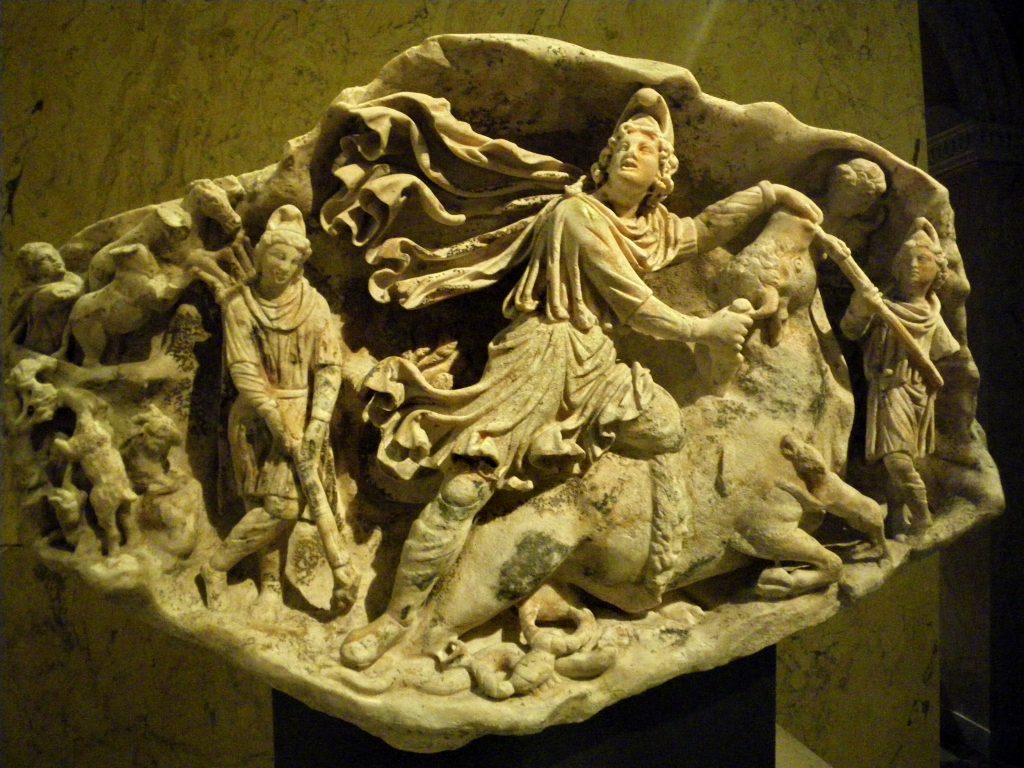
CC BY-SA 3.0
Images depicting these scenes are found in Mithraeums across the world. The most significant of them being the slaying of the bull which was prominently displayed above the alter.
With the conversion of Roman Emperor Constantine to Christianity in 312 AD, mystery religions fell into decline.
Christian propaganda cast Mithraism as a barbaric cult that forced initiates through humiliating and painful ordeals.
If these tales failed to stop a population praising their pagan gods, gangs of monks would turn up and destroy the Mithraeum.
However, this active persecution generally wasn’t necessary.
Mithratic ‘devotees’ were predominantly from an ambitious Roman middle class who valued getting ahead over spiritual commitments. Keen to keep up with the spiritual zeitgeist, they quickly abandoned their old gods – Christ simply offered better networking opportunities than Mithras.
By the early 5th century Mithraism had largely disappeared.
The London Mithraeum – Mithras’ moving temple
In the early 1950s, insurance firm Legal and General began construction of a new 170 foot, 14-floor modernist headquarters. A plot on Cannon Street was selected and applications submitted for what would be known as ‘Bucklersbury House’.
In 1952 the contractors began to prepare the site. As they dug to lay the deep foundations, they hit a problem – they had discovered the Londinium Temple of Mithras.
A media circus ensued and the public, fascinated by the find, turned up in droves. On some days over 30,000 would queue to see the remains.

Renowned archaeologist William Grimes was called in to excavate the site. As the scale of the find began to become clear, Parliament and the press began to debate what should happen with the ruin.
Fearing that the plans for their building might be halted, the developer came up with a compromise: painstakingly dismantling then reconstructing the temple 100 metres down the road.
Perhaps unsurprisingly, the developers weren’t as careful as they had promised to be. Like an impatient child trying to finish a puzzle, they crammed pieces together. If a piece didn’t fit it was swiftly discarded. Any gaps were filled with Kentish ragstone.
After the reopening of the temple in 1962, Grimes commented “My suggestions were completely ignored … The result is virtually meaninglessas as a reconstruction of a Mithraeum.”
In 2007 Bucklersbury House was demolished to make way for Bloomberg’s new European Headquarters. Bloomberg agreed to take responsibility for the Mithraeum and relocate the ruin to its original home.
Fortunately, Bloomberg took more care with the Mithraeum than Legal and General had done – for a start, they consulted archaeologists on its reconstruction.
It now lies seven metres below modern ground level, slightly to the west of its original location.
Visiting – The London Mithraeum today
As you enter the ‘Bloomberg Space’ you notice a strange juxtaposition between the ultra-modern design of the building and the ancient temple you have come to visit.
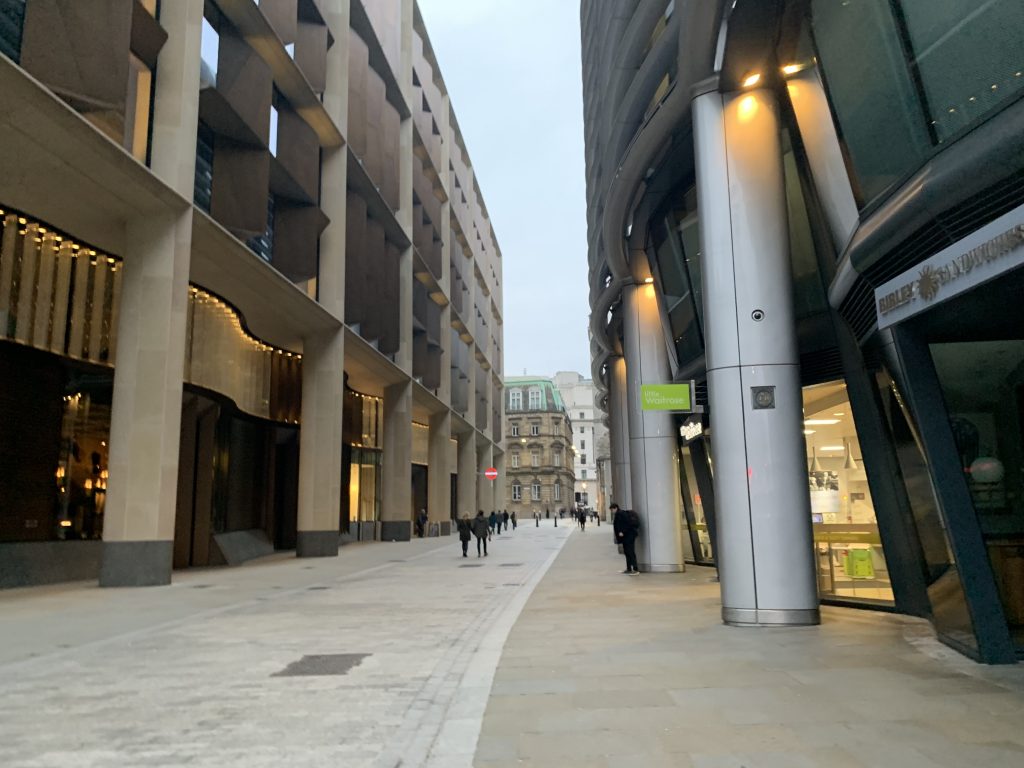
This disconnect continues throughout a visit to the Mithraeum.
Super-slick, polished jet black information boards and touch screen tablets greet you throughout. Underutilised high resolution displays provide a countdown to the next tour group’s entry.
This is a corporate take on a museum.
The contrast doesn’t detract from the exhibit; rather it assists in highlighting the ever-changing face of London.
Bloomberg have you descend deep underground to visit the Mithraeum, splitting the exhibit across three floors:
Ground Floor
Entering on the ground floor you will be asked to show your tickets and enter a waiting area.
You are in what is perhaps the most fascinating part of the site. A space has been created for artists to display work inspired by the Mithraeum. This changes on a regular schedule – during our visit we saw some rather beautiful pottery crafted by German artist Claudia Wieser.
Though, unfortunately for Claudia, the artists’ work is overshadowed by a giant wall of roman artefacts on display. Each item is carefully set on an embossed sky-blue tile to create a stunning mosaic that could rival the Roman tilers themselves. As you step towards the display, the intricate detail of carved knives, roman doors and glistening jewellery reveals itself.
The Mezzanine Floor
When your time slot begins, you will be called down to the mezzanine floor where three moulded replicas relating to Mithras are on display. Whilst standing in this area the mellifluous tones of Joanna Lumley are heard over the PA system providing background on the cult and the temple.
No information is provided in the room housing the Mithraeum itself, and the dimmed lights make it difficult to read the well-produced (and free) guide book – so make sure you take in all the information you can whilst on the Mezzanine floor.
The Mithraeum
You will eventually be told to head down to the third and final level: The Mithraeum itself.

Paths have been installed around the edge leading to the rear of the alter. A glass walkway has been constructed that takes you about a quarter of the way down the central nave. At the end the nave is the traditional image of Mithras killing a bull.
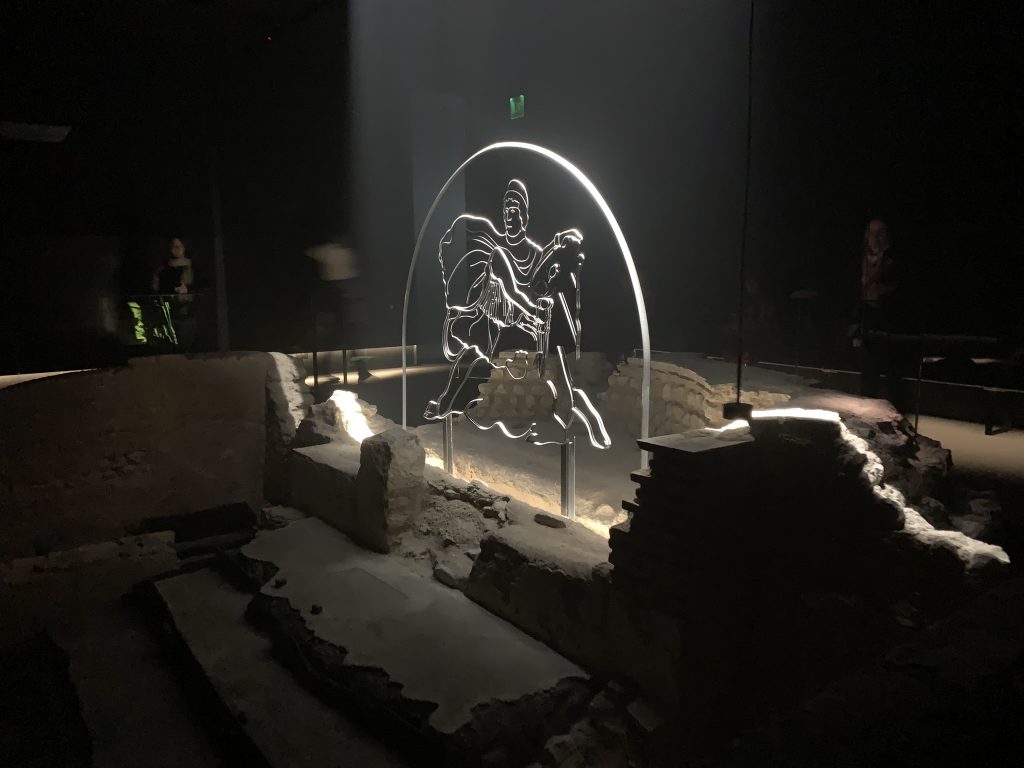
After a few minutes an immersive experience will begin. Lights will shine down on carefully placed blocks casting shadows that appear to be ghostly columns along the edge of the temple. Over the PA, the sound of brisk footsteps can be heard, giving way to the imagined incantations of an ancient Mirtatic initiate.
Getting There
Entry to the exhibit and Mithraeum is free, but tickets mustbe booked in advance. Visit https://www.londonmithraeum.com/visit/#book-your-visit to book your time slot.
The site is very well placed for public transport, beingalmost next to Cannon Street Station and Underground.
Nearby
Just round the corner is the London Stone – an irregular block of oolitic Limestone that has been venerated as an object of significance for over 900 years. It plays a part in many London folktales. The London Stone can be found in a case outside 111 Cannon Street.
Also nearby is London’s Roman Amphitheatre. This can be found under the Guildhall art gallery. Entry is free, but it can close at short notice so keep an eye on the City of London website.
Sources and Further Reading
Franz Cumont, ‘The Mysteries of Mithra’ (1st Eng.tr. 1903, Forgotten Books, 2012)
Roger Beck, ‘The Religion of the Mithras Cult in the Roman Empire: Mysteries of the Unconquered Sun’ (Oxford University Press, 2007)
http://www.sacred-texts.com/cla/mom/index.htm
http://www.plekos.uni-muenchen.de/2010/r-beck.pdf
http://www.bbc.co.uk/history/ancient/romans/paganshadowchrist_article_01.shtml
In our time, the cult of Mithras Radio 4 https://www.bbc.co.uk/programmes/b01pg5nt
https://www.theguardian.com/uk/2012/jan/19/roman-temple-mithras

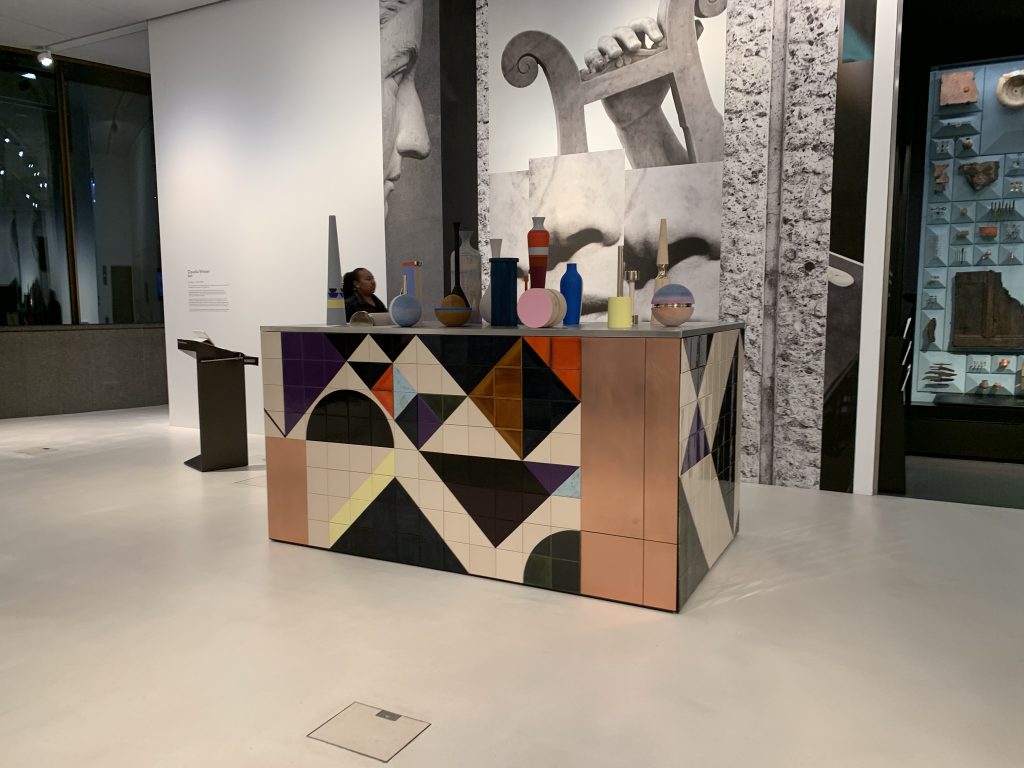
1 Comment